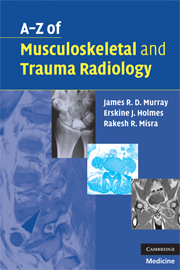Book contents
- Frontmatter
- Contents
- Acknowledgements
- Preface
- List of abbreviations
- Section I Musculoskeletal radiology
- Achilles tendonopathy/rupture
- Aneurysmal bone cysts
- Ankylosing spondylitis
- Avascular necrosis – osteonecrosis
- Femoral-head osteonecrosis
- Kienböck's disease
- Back pain – including spondylolisthesis/spondylolysis
- Bone cysts
- Bone infarcts (medullary)
- Charcot joint (neuropathic joint)
- Complex regional-pain syndrome
- Crystal deposition disorders
- Developmental dysplasia of the hip (DDH)
- Discitis and vertebral osteomyelitis
- Disc prolapse – PID – ‘slipped discs’ and sciatica
- Diffuse idiopathic skeletal hyperostosis (DISH)
- Dysplasia – developmental disorders
- Enthesopathy
- Gout
- Haemophilia
- Hyperparathyroidism
- Hypertrophic pulmonary osteoarthropathy
- Irritable hip/transient synovitis
- Juvenile idiopathic arthritis
- Langerhans-cell histiocytosis
- Lymphoma of bone
- Metastases to bone
- Multiple myeloma
- Myositis ossificans
- Non-accidental injury
- Osteoarthrosis – osteoarthritis
- Osteochondroses
- Osteomyelitis (acute)
- Osteoporosis
- Paget's disease
- Perthes disease
- Pigmented villonodular synovitis (PVNS)
- Psoriatic arthropathy
- Renal osteodystrophy (including osteomalacia)
- Rheumatoid arthritis
- Rickets
- Rotator-cuff disease
- Scoliosis
- Scheuermann's disease
- Septic arthritis – native and prosthetic joints
- Sickle-cell anaemia
- Slipped upper femoral epiphysis (SUFE)
- Tendinopathy – tendonitis
- Tuberculosis
- Tumours of bone (benign and malignant)
- Section II Trauma radiology
Hyperparathyroidism
from Section I - Musculoskeletal radiology
Published online by Cambridge University Press: 22 August 2009
- Frontmatter
- Contents
- Acknowledgements
- Preface
- List of abbreviations
- Section I Musculoskeletal radiology
- Achilles tendonopathy/rupture
- Aneurysmal bone cysts
- Ankylosing spondylitis
- Avascular necrosis – osteonecrosis
- Femoral-head osteonecrosis
- Kienböck's disease
- Back pain – including spondylolisthesis/spondylolysis
- Bone cysts
- Bone infarcts (medullary)
- Charcot joint (neuropathic joint)
- Complex regional-pain syndrome
- Crystal deposition disorders
- Developmental dysplasia of the hip (DDH)
- Discitis and vertebral osteomyelitis
- Disc prolapse – PID – ‘slipped discs’ and sciatica
- Diffuse idiopathic skeletal hyperostosis (DISH)
- Dysplasia – developmental disorders
- Enthesopathy
- Gout
- Haemophilia
- Hyperparathyroidism
- Hypertrophic pulmonary osteoarthropathy
- Irritable hip/transient synovitis
- Juvenile idiopathic arthritis
- Langerhans-cell histiocytosis
- Lymphoma of bone
- Metastases to bone
- Multiple myeloma
- Myositis ossificans
- Non-accidental injury
- Osteoarthrosis – osteoarthritis
- Osteochondroses
- Osteomyelitis (acute)
- Osteoporosis
- Paget's disease
- Perthes disease
- Pigmented villonodular synovitis (PVNS)
- Psoriatic arthropathy
- Renal osteodystrophy (including osteomalacia)
- Rheumatoid arthritis
- Rickets
- Rotator-cuff disease
- Scoliosis
- Scheuermann's disease
- Septic arthritis – native and prosthetic joints
- Sickle-cell anaemia
- Slipped upper femoral epiphysis (SUFE)
- Tendinopathy – tendonitis
- Tuberculosis
- Tumours of bone (benign and malignant)
- Section II Trauma radiology
Summary
Characteristics
Parathormone excess may be primary, secondary or tertiary.
Primary Hyperparathyroidism (HPT) is most common, characteristically occurring in women (3:1) over 50. A single adenoma accounts for > 90% of all cases; carcinoma is rare (1%). Parathyroid hyperplasia usually occurs in multiple endocrine neoplasia syndromes.
Secondary HPT results secondary to prolonged hypocalcaemia. Calcium levels are normalised at the expense of bone turnover. Associated with chronic renal failure, osteomalacia and malabsorption states.
Continuous stimulation of the parathyroid glands can result in adenoma formation and autonomous secretion of parathormone. This is known as tertiary hyperparathyroidism.
Clinical features
May be asymptomatic and only diagnosed from biochemical tests.
Features tend to be related to hypercalcaemia. The adage of ‘moans, bones, stones and abdominal groans’ still applies.
Polydipsia, polyuria, lethargy, somnolence, confusion and depression are common. Suspect in the patient presenting with renal colic as up to 20% of recurrent stone formers may have underlying HPT.
Can cause anorexia, nausea, constipation and even peptic ulceration.
Radiological features
Subperiosteal bone resorption, seen as a lace-like pattern, occurs along the bony cortex. The earliest changes are seen at the phalangeal tufts and radial aspect of the middle phalanx of the index and middle fingers, clavicles and proximal humerus.
Bone softening results in vertebral wedging and bowing of long bones.
Brown tumours – localised replacement of bone by vascular fibrous tissue secondary to the action of osteoclasts. Commonest in the jaw, pelvis and rib.
Soft tissue calcification – occurs more commonly with secondary HPT. May result in chondrocalcinosis of hyaline and fibrous cartilage (wrist, knee menisci, shoulder and hip).
Osteosclerosis – again seen more commonly in secondary HPT. Predilection for the axial skeleton – ‘rugger-jersey spine’ due to vertebral endplate sclerosis.
[…]
- Type
- Chapter
- Information
- A-Z of Musculoskeletal and Trauma Radiology , pp. 68 - 70Publisher: Cambridge University PressPrint publication year: 2008



